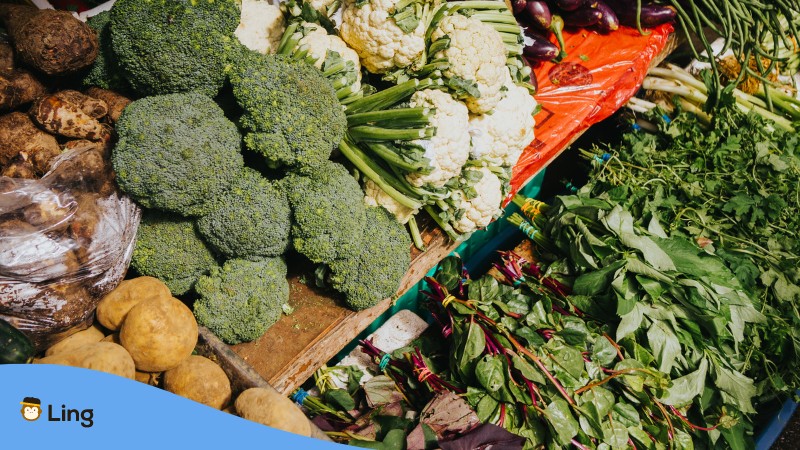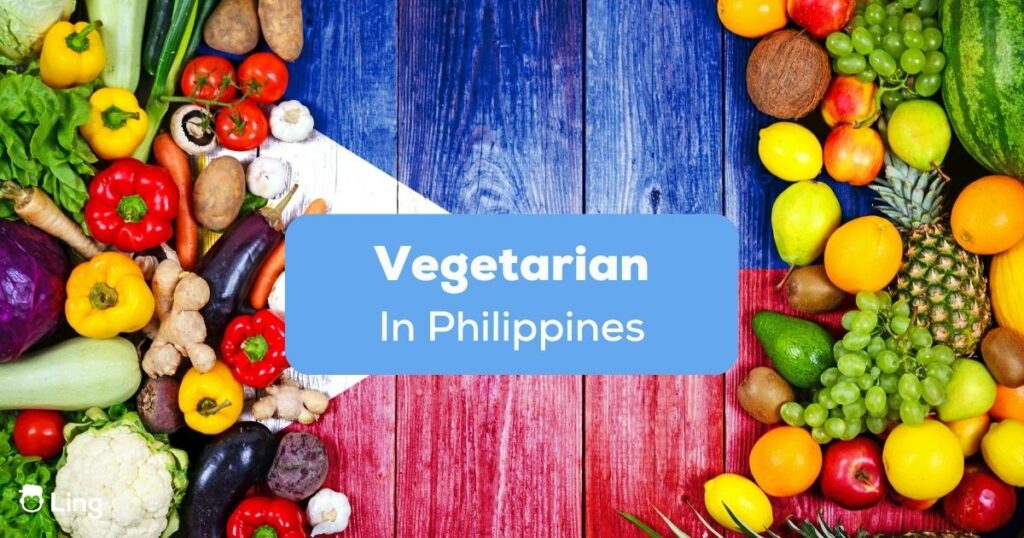Hello there, fellow foodie! Are you a veggie or a vegan traveling to the Philippines and worried about meat-centric cuisine? No worries, my friend!
Despite the love of meat, being a vegetarian in Philippines is becoming more and more common. In this post, we’ll go over everything you need to know about this diet and the best Tagalog words to remember when ordering food. Let’s start!
Are you a seasoned plant-based eater? Or just looking to cut back on meat for ethical or health reasons? Whatever reason you have, you’ll be happy to know that there are plenty of delicious vegetarian options for you in the Philippines!
The Philippines got everything from fish, salads, coconut, and vinegar to fresh fruits, sticky rice, and mock meat. Read on and prepare for a satisfying, meat-free experience in this vibrant, tropical country!
Understanding The Philippine Cuisine
Alright, let’s talk about the fantastic cuisine of the Philippines! This Asian country has a rich and diverse culinary heritage, with influences from Spanish, Chinese, and indigenous cultures. And when it comes to traditional Filipino food, there are some key ingredients you have to know about.
Bigas (Rice) – The Staple Of Filipino Cuisine
Rice is a staple food in the country and is an essential part of almost every meal. It’s so crucial to Filipino cuisine that there’s even a saying, “Walang ulam na walang kanin,” which roughly translates to “there’s no dish without rice.”
Niyog (Coconut) – A Rich And Creamy Addition
Coconut is a versatile ingredient that’s used in many traditional Filipino dishes. Its rich and creamy flavor adds depth and complexity to dishes, making it an essential part of the Philippine culinary landscape. In the Philippines, you can find coconut in various forms, including coconut milk, coconut oil, and grated coconut. Coconut milk is often used as a base for soups and stews, while coconut oil is used for cooking.
Suka (Vinegar) – Adding A Tangy Balance
Vinegar is a staple condiment in the Philippines, used to add tang and balance to dishes. It’s often paired with soy sauce to create a flavorful dipping sauce for dishes like lechon (roast pig) and lumpia (spring rolls). The most common is cane vinegar, which has a slightly sweet and tangy flavor.
Toyo (Soy Sauce) – Adding Depth Of Flavor
Soy sauce is another staple condiment in the Philippines, used to add depth of flavor to dishes. It’s used in marinades, sauces, and as a dipping sauce. In the Philippines, a soy sauce called toyomansi is commonly used, a mixture of soy sauce and calamansi or vinegar.
Patis (Fish Sauce) – Bringing A Savory Umami Flavor
Fish sauce, made from fermented fish, is used as a seasoning in many traditional Filipino dishes. Its savory and slightly salty flavor adds an umami touch to dishes, making it an essential ingredient in dishes like sinigang (sour soup) and adobo (stewed meat).
Alamang/Bagoong (Shrimp Paste) – Adding A Pungent Saltiness
Shrimp paste, made from fermented shrimp, is used as a seasoning in many traditional Filipino dishes. Its pungent and salty flavor adds a unique touch to dishes. This makes it an important ingredient in dishes like bagoong (shrimp paste sauce) and kare-kare (oxtail stew). Despite its strong flavor, a little shrimp paste goes a long way, so use it sparingly!
Popular Dishes In The Philippines
So, now that you know the common Tagalog ingredients of traditional Filipino cuisine, let’s talk about some of the most popular dishes for a vegetarian in the Philippines!
- Kare-kare: A stew made with oxtail, vegetables, and a peanut-based sauce.
- Adobo: A stew made with meat (typically chicken or pork) cooked in soy sauce, vinegar, and garlic.
- Lechon: Roast pig, typically served as a special occasion dish.
- Purple Yam: A sweet, starchy root vegetable often used in desserts like cakes and ice cream.

Popular Vegan Foods And Dishes In The Philippines
When finding vegan options in the Philippines, many dishes cater to plant-based diets. Here are some of the most popular dishes:
Vegetable Dishes
- Bitter gourd: This bitter vegetable is often stir-fried with garlic, onions, and soy sauce to make a delicious side dish.
- Steamed vegetables: Steamed vegetables such as bok choy and carrots make for a simple yet healthy dish.
- Taro leaves: Often used to wrap savory fillings in popular Tagalog foods.
- Ginataang kalabasa: A stew made with squash and coconut milk.
Vegan Filipino Foods
- Tofu: A versatile ingredient in various vegetarian dishes, including stir-fry, soups, and stews.
- Mock meat: Many vegetarian restaurants in the Philippines offer mock meat dishes made from soy protein or gluten to mimic the taste and texture of meat.
- Fresh fruits: Fresh fruit bowls are a popular option for breakfast or as a snack.
- Sticky rice: Sticky rice is a staple in the Philippines and can be found in many vegan restaurants.
Popular Vegan Filipino Dishes
- Kare-kare: This traditional Filipino dish is typically made with beef or goat but can also be made with mock meat for a vegan version.
- Purple yam (ube): This sweet and starchy root vegetable is also used to make savory dishes like “ube halaya,” – a creamy and delicious dish often served as a dessert or snack.
- Sinigang: A sour soup made with tamarind and usually featuring vegetables such as eggplant, tomatoes, and okra.
- Tofu and vegetable adobo: A vegan take on the traditional adobo, made with tofu and various vegetables instead of meat.
- Biko: A sweet sticky rice dessert made with coconut milk, sugar, and glutinous rice.
Basic Tagalog Words For Vegans In the Philippines
If you’re a vegetarian traveling to the Philippines, here are some fun and important Tagalog words to help you out:
Avoiding Non-Vegetarian Food And Ingredients
When eating out in the Philippines, be aware of common non-vegetarian ingredients like shrimp paste and fish sauce, often used in traditional Filipino dishes. Some restaurants may be able to make modifications to accommodate dietary restrictions. Still, it’s always best to learn Tagalog to communicate clearly and ensure that your meal is vegetarian.
Here are a few useful phrases to help you avoid non-vegetarian ingredients in the Philippines:
Avoiding non-vegetarian ingredients might sound daunting, but with a few key Tagalog phrases in your back pocket, you’ll be able to confidently communicate your dietary restrictions and ensure that your meal is free from any animal products. So don’t be shy! Give these phrases a try, and have a scrumptious, meat-free vacation!

Finding Vegan Restaurants In The Philippines
So, you’ve landed in the Philippines and are eager to explore local cuisine. But, as a vegetarian or vegan, you’re unsure where to begin. Well, there are many vegan restaurants in the Philippines, particularly in metro Manila, Davao City, Cebu City, and Quezon City. Here are some tips for navigating the plant-based food scene in the Philippines:
Look For Vegetarian Restaurants
As mentioned earlier, many vegetarian and vegan restaurants are popping up in cities across the Philippines. These restaurants cater specifically to plant-based diets and offer a wide range of options, from mock meat dishes to fresh salads and fruit bowls.
Check Out Local Markets
Another great way to find vegan food options in the Philippines is by exploring local markets. You’ll find a wide range of fresh fruits and vegetables and street vendors offering Filipino vegan food.
Be Mindful Of Hidden Ingredients
When dining at traditional restaurants or street food stalls, be mindful of hidden ingredients in dishes that might not be vegetarian or vegan. For example, many dishes in the Philippines contain shrimp paste or fish sauce, so double-check with the vendor before ordering food.
Get Creative With Sides
If you’re having trouble finding main Filipino vegetable dishes that meet your dietary restrictions, try ordering a few side dishes instead. Rice and steamed vegetables are always a safe bet, and many restaurants will also offer fresh fruit and salads.
Tagalog Phrases When Searching For A Vegan Restaurant
Here are some conversational Philippine phrases to help you find a vegetarian restaurant or eatery in the Philippines:
| English | Tagalog |
| Where can I find a vegetarian restaurant? | Saan ako makakahanap ng vegetarian restaurant? |
| Do you have any vegetarian options? | Mayroon ka bang vegetarian na pagpipilian? |
| Do you know any vegetarian restaurants nearby? | May alam ka bang vegetarian na restaurant na malapit? |
| Where is the nearest vegetarian restaurant? | Saan ang pinaka malapit na vegetarian na restaurant? |
| Is this restaurant vegetarian-friendly? | Ito ba ay vegetarian-friendly na restaurant? |
Awesome! Now you’re all set to explore the delicious world of vegetarian cuisine in the Philippines! Remember, don’t be afraid to ask and use these phrases. The locals are always happy to help. So go ahead, satisfy your taste buds, and enjoy the vibrant flavors of Filipino food!

Learn Tagalog With The Ling App
With these important Tagalog words and phrases for vegetarians, you’ll be able to enjoy being a vegetarian in the Philippines and its fantastic cuisine like a pro! Knowing these words will definitely come in handy when dining out and communicating with Filipino people.
To take your Tagalog skills to the next step, check out the Ling app. It’s packed with fun mini-games and quizzes that will make learning Tagalog a breeze. Download the Ling app today for FREE from the App Store or Google Play, and start your journey to becoming a fluent Tagalog speaker today!



















